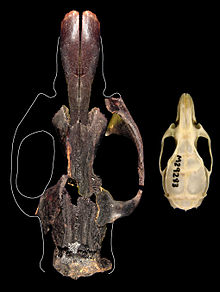Sue O'Connor
Sue O'Connor is an Australian archaeologist .
job
O'Connor studied at the University of New England in Australia , where she received her bachelor's degree, and the University of Western Australia , where she received her PhD . She is a professor in the School of Culture, History & Language at the Australian National University in Canberra .
She is an expert in archeology in New Guinea and the Pacific Islands, excluding New Zealand , and the Aboriginal and Torres Strait Islanders . Her research area deals with the archeology in Australia and Southeast Asia , the Pleistocene colonization of Australia, Papua New Guinea and the islands of Southeast Asia by anatomically modern humans ( Homo sapiens ) and the connection between these regions and with the changes and continuity after the end of the Neolithic in the island world of Southeast Asia. Added to this are the human influence on the environment and cave paintings .
O'Connor is currently working on an archaeological project in East Timor that will investigate the cultural and environmental changes in the transition from the Neolithic to the Metal Age. Previous research has already been carried out in the eastern Moluccas and other places in Wallacea . Research is being carried out in Papua New Guinea at the same time. The Pleistocene colonization of the island world of Southeast Asia, Australia and its surroundings and their consequences are examined.
O'Connor received the Awarded Australian Research Council Laureate Fellowship in 2012 and was a member of the Awarded Australian Research Council QEII Fellowship (1999–2003) with the project “Characterizing the Island Southeast Asian Neolithic Transition: a comparison of preceramic and ceramic (Neolithic) maritime cultures " .
Notable finds


Sue O'Connor was already working on various sites in East Timor in the 1990s. In Ile Kére Kére and Lene Hara , O'Connor was able to prove settlements that go back 30 to 35,000 years. In 2009 the team and O'Connor found faces in Lene Hara that were engraved in the stone and estimated to be 10,000 years old.
In Jerimalai , O'Connor found traces of human settlement that are more than 42,000 years old (38,255 ± 596 BP in test cut A and 37,267 ± 453 BP for test cut B (Wk-17833)) older than other finds between mainland Southeast Asia and Australia. They corroborate the theory that anatomically modern humans spread from Asia to Australia on the southern route via the Lesser Sunda Islands and not via the northern route via Borneo , Sulawesi and New Guinea . O'Connor therefore describes the site as world-important. Earlier finds on the islands of the southern route were far too young to prove this path of spread. Fragments of the world's oldest known fish hook have also been found in Jerimalai. It is estimated to be between 16,000 and 23,000 years old. Shells that were made into a necklace and that were also found on the eastern tip of Timor were estimated to be 6,500 years old. They are testimony to the second oldest mussel necklace in the world.
In the Matja Kuru cave, O'Connor's team discovered the remains of the extinct rat Coryphomys musseri and a piece of bone that was part of a 35,000-year-old harpoon and represents the oldest relic of the complex binding technology used in the region.
Publications (selection)
- Nine New Painted Rock Art Sites from East Timor in the context of the Western Pacific Region. In: Asian Perspectives . 42, No. 1, 2003, ISSN 0066-8435 , pp. 96-128.
- with John Norman Miksic, Geok Yian Goh: Rethinking Cultural Resource Management in Southeast Asia. Preservation, Development, and Neglect. 2011, ISBN 978-0-85728-389-4 , pp. 49ff
Web links
Individual evidence
- ^ Sue O'Connor, Matthew Spriggs, Peter Veth: Excavation at Lene Hara Cave establishes occupation in East Timor at least 30,000-35,000 years ago. ( Memento of the original from September 23, 2015 in the Internet Archive ) Info: The archive link was inserted automatically and has not yet been checked. Please check the original and archive link according to the instructions and then remove this notice. In: Antiquity. March 2002, 76, 291, p. 45. (PDF; 1.2 MB)
- ^ Scientists find 10,000-year-old stone carvings. on: abc.net.au , February 11, 2011.
- ^ Sue O'Connor: New evidence from East Timor contributes to our understanding of earliest modern human colonization east of the Sunda Shelf . ( Memento of the original from September 23, 2015 in the Internet Archive ) Info: The archive link was inserted automatically and has not yet been checked. Please check the original and archive link according to the instructions and then remove this notice. (PDF; 659 kB) In: Antiquity 81, 2007, ISSN 0003-598X , pp. 523-535.
- ^ Sue O'Connor et al .: Pelagic Fishing at 42,000 Years Before the Present and the Maritime Skills of Modern Humans , Science, Vol. 334, p. 1117, 2011
- ↑ SAPO: Colar de conchas com 6.500 anos ajuda a datar comunidades em Timor-Leste , August 3, 2015 , accessed on October 15, 2015.
- ↑ KP Aplin, KM Helgen: Quaternary Murid Rodents of Timor. Part I: New Material of Coryphomys buehleri Schaub, 1937, and Description of a Second Species of the Genus. In: Bulletin of the American Museum of Natural History. 341, 2010, pp. 1-80, doi : 10.1206 / 692.1
- ^ S. O'Connor, G. Robertson, KP Aplin: Are osseous artefacts a window to perishable material culture? Implications of an unusually complex bone tool from the Late Pleistocene of East Timor in Journal of Human Evolution, January 15, 2014, accessed January 23, 2014
| personal data | |
|---|---|
| SURNAME | O'Connor, Sue |
| BRIEF DESCRIPTION | Australian archaeologist |
| DATE OF BIRTH | 20th century |